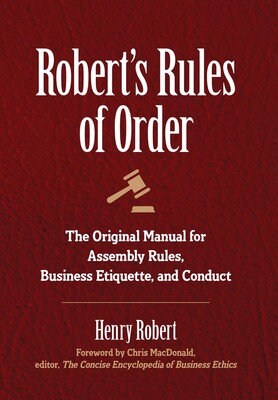Roberts Rules of Order (updated 2023)
Guidelines to Successful Board Meetings
First published in 1876, Robert's Rules of Order is a popular guidebook for board meeting procedures. Originally written by Henry M. Robert in 1876, they have been revised a number of times since then.

The Rules are designed to ensure that meetings are conducted according to a structure that promotes fairness and order. This structure aims to ensure that all members get a chance to be heard, and that fair decisions are made in a time-efficient manner.
Here is a summary of the various rules:
The Order of Business
An order of business should be established before the meeting.
The order is is a predetermined sequence of items that are covered in a meeting. It is easy to confuse the order of business with the agenda, but there are some key differences but remember that the agenda is a list of topics to be discussed at the meeting as opposed to a sequence of items to be covered. Also the agenda often changes from meeting to meeting.
Here are some common order of business items, which are normally ordered by relative importance:
- calling the meeting to order
- attendance register
- reading of the minutes
- reports from company officers
- committee reports
- unfinished business
- new business
A Quorum
A quorum is the minimum number of members who must be present for the meeting to be valid. The quorum is usually set by the organization's MOA but if not, then a simple majority is used.
-
Agenda: The agenda should be distributed to all members before the meeting, and any member may request that an item be added to the agenda. The chairperson should also ensure that there is enough time to discuss each item on the agenda.
-
Motions: Motions are proposals made by members that require a second before they can be discussed. The chairperson should restate the motion before the discussion begins and should also call for a vote after the discussion has ended.
-
Debate: All members have the right to speak on a motion, but they should address their comments to the chairperson rather than to other members. Members should also avoid attacking other members or making personal attacks.
-
Voting: Members should be given the opportunity to vote on a motion, and the chairperson should announce the result of the vote. The chairperson should also ensure that the vote is conducted fairly and that all members have an equal opportunity to vote.
-
Amendments: Amendments are changes made to a motion before it is voted on. A motion to amend should be seconded and discussed before it is voted on.
-
Points of Order: Members may raise a point of order if they believe that the rules of the meeting are not being followed. The chairperson should rule on the point of order and should enforce the rules of the meeting.
-
Executive Sessions: Executive sessions are private meetings that are held by the board without the presence of non-board members. The rules for executive sessions should be established in the organization's bylaws.
-
Minutes: The minutes of the meeting should be taken and distributed to all members. The minutes should include the date, time, and location of the meeting, the names of those present, a summary of all motions and actions taken, and any decisions made.

